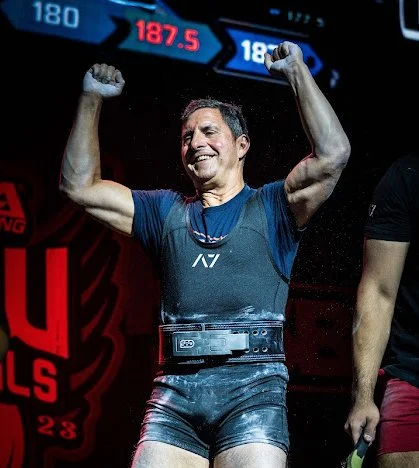Mike Mayo
Strength Training to Combat Osteoporosis
By Mike Mayo
For 40 years, cardio was my main activity, from marathons to later long distance cycling, including 100 mile “century” rides. I learned, however, that this type of non-weight bearing exercise, while good for my cardiovascular health (my heart is fine), did not help my bone health. Four years after discovering my osteoporosis – now at age 60 – I no longer have it. My big change was making my occasional weight lifting front-and-center. Strength training became my primary exercise.
I may be a good use case for both ignorance of and then progress with osteoporosis. I’m busy, working as an analyst at Wells Fargo Securities. I was in denial about my problem for most of my 50s until I was forced to change. The result is an almost one-fifth increase in my bone density. I learned that I have some degree of control over my bone health, even if my story might get termed “Osteoporosis for Dummies.”
My “ah ha” moment came when I was filling out the 10+ page form in the endocrinologist’s office - I didn’t know why I was there or what this doctor even does. Deep in this bureaucratic form - past my social security number, insurance information, and other check-the-boxes, came my moment of truth question. “How many bones have I broken in the past 5 years?” After taking too long to count all the bones I broke, I realized the severity of my situation as I wrote down the number “15”.
The signs were there well before a bone density test gave a “T score” result worse than negative 3, or what I interpreted as having bones like toothpicks. For any bone breaks, I’d attribute it to the ski mountain, the bike trail, the tree that got in my way. A surgeon actually asked me, “Do you smoke?” (I do not, but who knew that smoking was so bad for your bones, too).
I should have paid more attention to my family history, especially since my mother, father, aunt, and many others had weak bones. I failed to make the connection that this should impact how I live my life – mountain biking down a ski mountain and over “drops” was pure idiocy. So is something as simple as not holding onto the handrail when walking down stairs to the subway in New York City.
After breaking 10 bones from a bike accident in 2021, I finally had no choice but to change my habits. It helped to see how my father, at age 80, recovered from a broken hip through determined day-to-day exercise. I, too, decided to “control what I can control” as it relates to exercise; I took this to an extreme but, in this case, a healthy one.
I specifically embraced “powerlifting” which combines three specific “lifts” in the gym. This includes what may be two of the most important activities that one can perform – squatting”, which simulates sitting down and standing up (pretty basic stuff for mobility and independence as we age); and deadlifting, or lifting the barbell off the floor (think picking up your kids or grandkids without hurting your back). I complemented these basic exercises with a variety of accessory strength training.
This journey has involved fits and starts, especially as I had to remind myself that it was okay to use lower weights while trying to improve my form. Yet, I sought progress over perfection, and used competition to further motivate me. After bombing my first meet two years ago, this year I went to the USA Powerlifting National Championships in Memphis where I placed 2nd in my masters category.
I feel like an evangelist for strength training. I’m quite proud of my 82-year-old mother-in-law who now seems like she is a decade younger. Never having lifted or even exercised much before, she started with “air squats” and worked her way to holding dumbbells; this has dramatically improved her mobility even though her vertebrae are fused together. Many say they won’t strength train because of their aches and pains, but I do so because of them and the ability to lessen them. It works!
Clearly, the strength training was only one part of the improvement in my bone health. I combined this with other exercise (walking 10,000 steps per day – i.e., another form of weight bearing impact), diet (supplemented by calcium, Vitamin D, and protein supplements), sleep (I try for more), and, of course, a series of medical intervention with my doctors at Hospital for Special Surgery.
I can honestly say that I feel better than I have in a long time. I no longer have osteoporosis. And most importantly, strength training helped my mental health. I proudly hang my powerlifting medal as a reminder that I have a degree of control over my bone health and I hope others can learn from this as well.
This story is part of a support initiative of the Bone Health and Osteoporosis Foundation called Voices of Osteoporosis: Stories of Hope and Inspiration. If you have experienced osteoporosis as a patient or caregiver, we invite you to share your story. Your story could inspire others to learn how to protect their ability to live their best life and stay bone strong. Click here to learn more.


